Wednesday, April 24, 1996
By Muniini K. Mulera
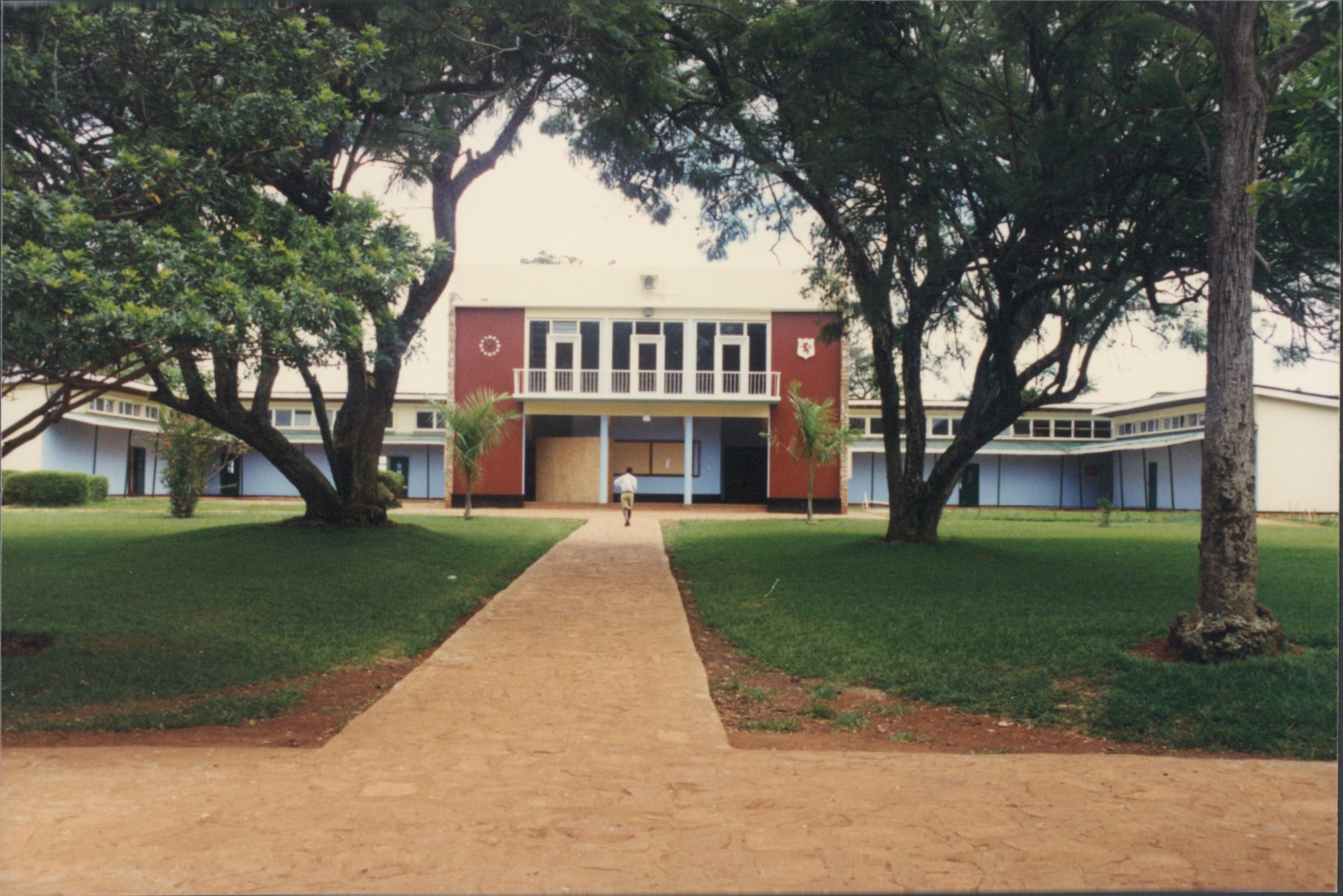 Big School (April 1996)
Big School (April 1996)
Today is Wednesday, April 24, 1996 and I am visiting King’s College Budo on this lovely sunny afternoon. I am most pleased to meet Dennis Mutabazi, son of an old friend, Arthur Gakwandi. Mutabaazi, a Senior 4 student, has offered to take me around the school and he is jogging my fading memory as he shares his experiences. I am very impressed by this young man’s courteous manner, which is quite refreshing.
I was last here in 1975 when I brought my youngest brother, Julius Musinguzi, to this school for his first time as Enjuka (newcomer). So much has changed, yet I feel the way I did many years ago when I first came to Budo as a student seeking after knowledge. There is a feeling of reverence for this campus, and wonderful memories of five short years spent here.
Those were the days of Ian Cameron Robinson, as head master of this school and my great teachers, among them: Ms. Susan Gould, Ms. Veronica Brunyette, Mr. Patrick Whittle, Mr. Roberts, Mr. Jonathan Watson, Mr. Neil Bonnell, Mr. Girard, Ms. Sarah Ntiro, Mr. Buchanan, Mr. John White, Mr. John Fyfe, Mr. Colin Davis, Mr. John Dodd, Mr. Patrick Boston, Mr. Weston, Mr. Brian Bowles, Mr. Bryan Wilson, Mr. Ayton, Rev. Hugh Sylvester, Mr. Neil Milford, Mr. Dennis Chisholm, Mr. Whybird, Mr. Burkitt, Dr. Tom Schroer and others.
My first impression this time is that this wonderful school, in its 90th year, has undergone a lot of physical, emotional and academic trauma (like everything else in Uganda).
I see that the old Australia House (by the Library Road) and the classrooms that we used next door are very run down, with broken windows and bricks that could collapse at anytime. My classroom (3A) is in desperate need of paint and repairs. Memories of my classmates flood back. Anyaku, Asinai, Baatuma, Bugonga, Bwogi…… the roll call … all the way down to Wilson…. If only we could all gather in here once again!
I find that the quadrangle between Mutesa House, Canada House, Ghana House, and the main Library is terribly unkempt with overgrown grass.
The Common Room of Ghana House is now used as sleeping quarters for some laborers and Ghana House is overcrowded with students. That Common Room had a Grundig Radiogram, on which we span many, many discs that gave us hours of aural joy. My favourite group was The Monkees.
The Embassy part of Ghana House is dirty with a lot of garbage strewn all over the place. There is a huge pile of stinking garbage between England House and Ghana Overseas.
I spoke to one of the A-Level students who assured me that he was very proud of Ghana House, but when I challenged him about the filth and rubbish around his dormitory, he just shrugged his shoulders.
The toilets are – well- an olfactory nuisance. How did we survive this for five years? I suppose a water flushing system would have been worse, given the chronic shortage/absence of water.
It is in these toilets that I learnt to smoke cigarettes, under the tutelage of Fred Nkuranga Rubereeza. Sadly he died in 1981 while fighting in the guerrilla war in Luwero. I miss you Fred! I quit smoking in March 1972.
The old Art Room has not changed. What was the head master’s office is now living quarters for students. Hard to imagine this venerable little house not serving as the nerve centre of the school.
The Head Master’s house is still used by the present Head Master, Mr. Samuel Busulwa. Sadly, on this very day, as we walk around the school, Mr. Busulwa is in the Chapel with well-wishers saying farewell to his son who died in Tanzania.
I am impressed by the cleanliness of the students, with their smart uniforms and courteousness that is very refreshing after many years of living in North America where many students appear to be unmannerly.
The old Library (previously W.H. Weatherhead’s Chapel) is also rundown. Next to it is evidence of a new Library going up. The new Kabaka of Buganda laid the foundation stone a month ago.
The old Laboratories are the same. The Muslim community, led by Dr. Suleiman Kiggundu, an old Budonian, have donated a lovely building to be used as a Laboratory and has been named in memory of Prince Badru Kakungulu, himself an Old Budonian.
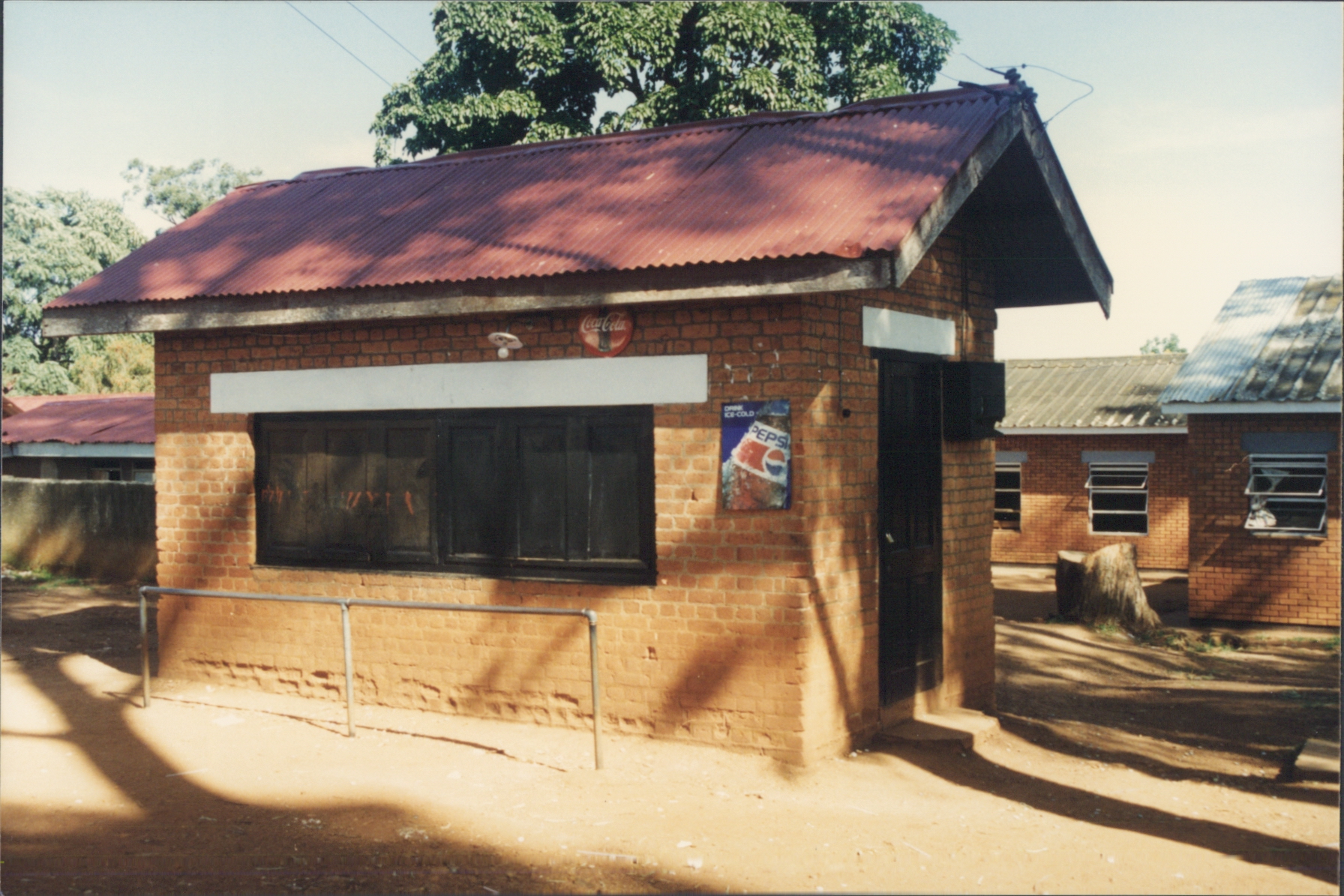 School Canteen (April 1996)
School Canteen (April 1996)
This new building is right next to the old school canteen (grocery store) that was run by the late Mr. Njulungi and his wife Dorothy during our time. Memories of moments spent at the Canteen, investing one’s common man’s salary in culinary delights, flood back. I will be visiting Dorothy Njulungi later today. She was always very kind to me.
Behind the main hall, across the main cricket and soccer fields, I note that the deputy head master’s house that was occupied by Mr. Watson and Mr. Dodd and Mr. Weston during our time appears to be in lovely condition.
The old Sanatorium is unchanged. I was a resident in here in 1968 when I came down with measles. Obviously survived it, with no adverse residual effects. (Measles can be very dangerous when acquired in adolescence or adulthood.) Nurse Mary Bogere is now retired.
What used to be the music room is not easy to identify except that it really is quite run down, with lots of broken windows. Memories of Mr. Brian Bowles introducing us to European Classical music!
The amount of garbage on the grounds is quite striking and you wonder whether the student body might not be encouraged to remove it.
I note that Africa House is once again called South Africa House in recognition of the independence of South Africa. During our time, of course, the name South Africa had been dropped in protest against the oppressive apartheid system in that Country.
 McKay Memorial Building (April 1996)
McKay Memorial Building (April 1996)
The wonderful old McKay Memorial Building that serves as the Dining Hall still looks very good. This Mess was Chief Caterer Mr. Kyanku’s department A lot of food was consumed in that Hall and those of us who were never shy to eat to our fill had quite the reputation of being benders.
The diet doesn’t seem to have changed very much. It is still your standard British military regimen of posho and beans. Might this partly explain why many of our colleagues ended up becoming oversized once they left school, perhaps in compensation?
The new (to me) Australia House sits where we used to board the school bus. This is between the Mess and what I still think of as Mr. John White’s house. I associate this area with Mr. Senkya, the suave manager of the school estate. Mr. White's house is now the Headmaster's office. Sacrilege! Somethings ought to be left alone.
The upper school and quadrangles look lovely. Interestingly, I cannot bring myself to walk on the grass. I can still hear Mr. Robinson telling Margaret Kyogyire to tell me not to do it almost 30 years ago.
The main hall has had a recent paint job and it has nice blue, red and black colors. The doors are green and the poles are green, but it is quite striking that at King’s College Budo, of all schools, the main hall colors are black, red, and blue. Times have changed.
The old clock says it is now 1:55, although truly it is now 23 minutes past four in the afternoon. The most striking thing is the amount of graffiti on the walls of these buildings.
The obsession with filth and pornographic graffiti is very troubling. Plenty of it drawn right next to the beautiful mural in the gallery area of the Main Hall. Unprintable language that would shock even the most hardened filth-spitting gangs of New York or Chicago.
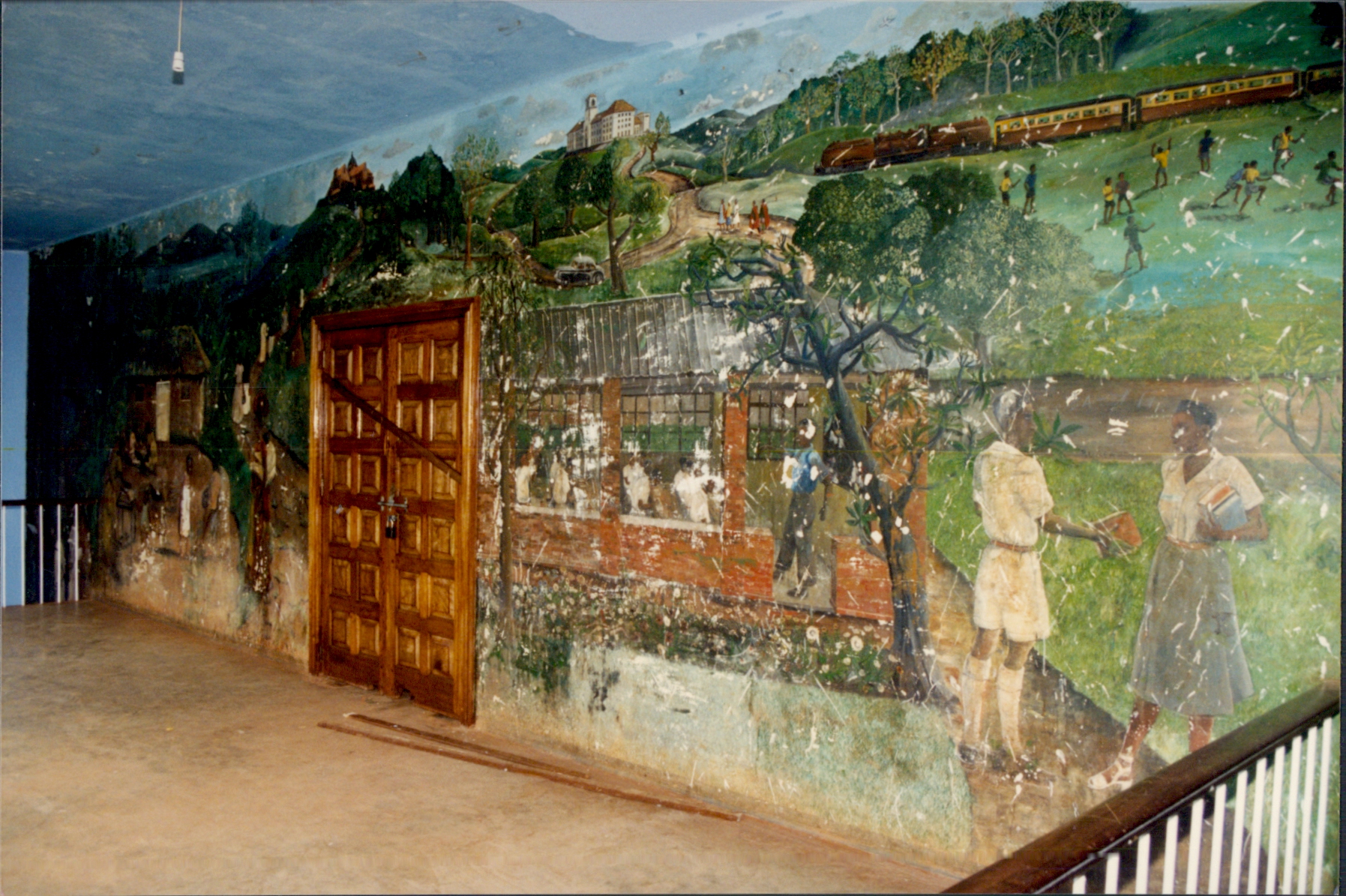
Desecrated mural (April 1996)
The Mural was, of course, the great work of David Barlow, Kadama Beyo, Frederick Irumba, John Kalisa, George Kalule, David Kato, Daniel Kyanda, John Lubuzi in 1956. It has been terribly damaged and I wonder whether it can be salvaged and restored to its great beauty.
This is the mural that shows the main hall of Makerere University and the hill with a car driving towards it with the students wearing Makerere red students’ gowns, and on another hill, Namirembe Cathedral with people clad in Busutis and Kanzus walking to church and then a Kiganda village with women and children carrying out their daily activities. On the other side is a classroom with students receiving instructions at Kings College Budo and on the far side, a leopard in the forest with three men with spears going to hunt.
Then on the other side, there is a train, a football match, someone on a bicycle, a woman going to a well, another one drawing water, a bus and an airplane in the corner. What a wonderful depiction of Uganda of 1956. I wonder what the same artists would paint if they retrieved their brushes in 1996.
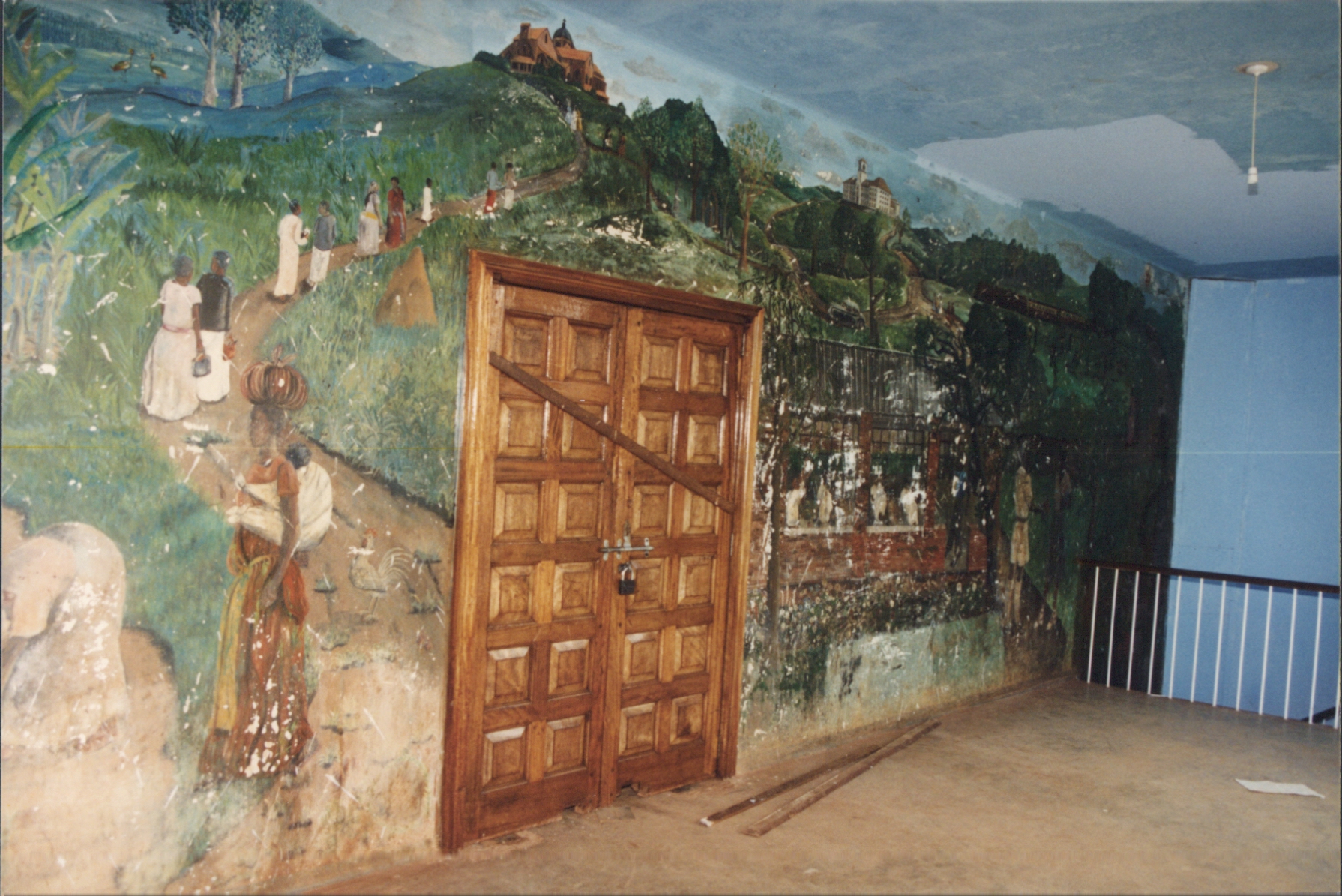
I note that the great doors that lead to the Main Hall Gallery are bolted shut. In my day, one walked in and out at will. We danced and sang in this Hall. The Jets and The Chants held musical court on this stage. We watched great movies here. I see Tartuffe (James Bahinguza), Makula ga Kulabako (Beatrice Bukirwa and James Birihanze) as though live.
And here we listened to excellent upper school lectures and great speeches by some of the great intellectuals of the day. This Hall ought to last centuries if we take care of it.
The Science Lecture Room, which was built in 1937 and was given to Budo as a gift of the Mengo Entebbe Ginners Association still looks quite good. It was in this very room that I first saw a television set. It showed black and white images and was only available to us on weekends.
We watched a lot of “Bonanza” and other American violence, and encountered live television news for the first time. I see and hear in my mind the voices of celebrated Uganda Television anchormen like Ben Kanyangyeyo, George Bisobolwa, James Bwogi and Cosima Warugaba.
Classrooms such as the old Biology Laboratory are locked with several padlocks, again a sign of the times. These used to be quite open places for students to go and study on their own whenever they wished, but now for fear of robberies, they must remain locked.
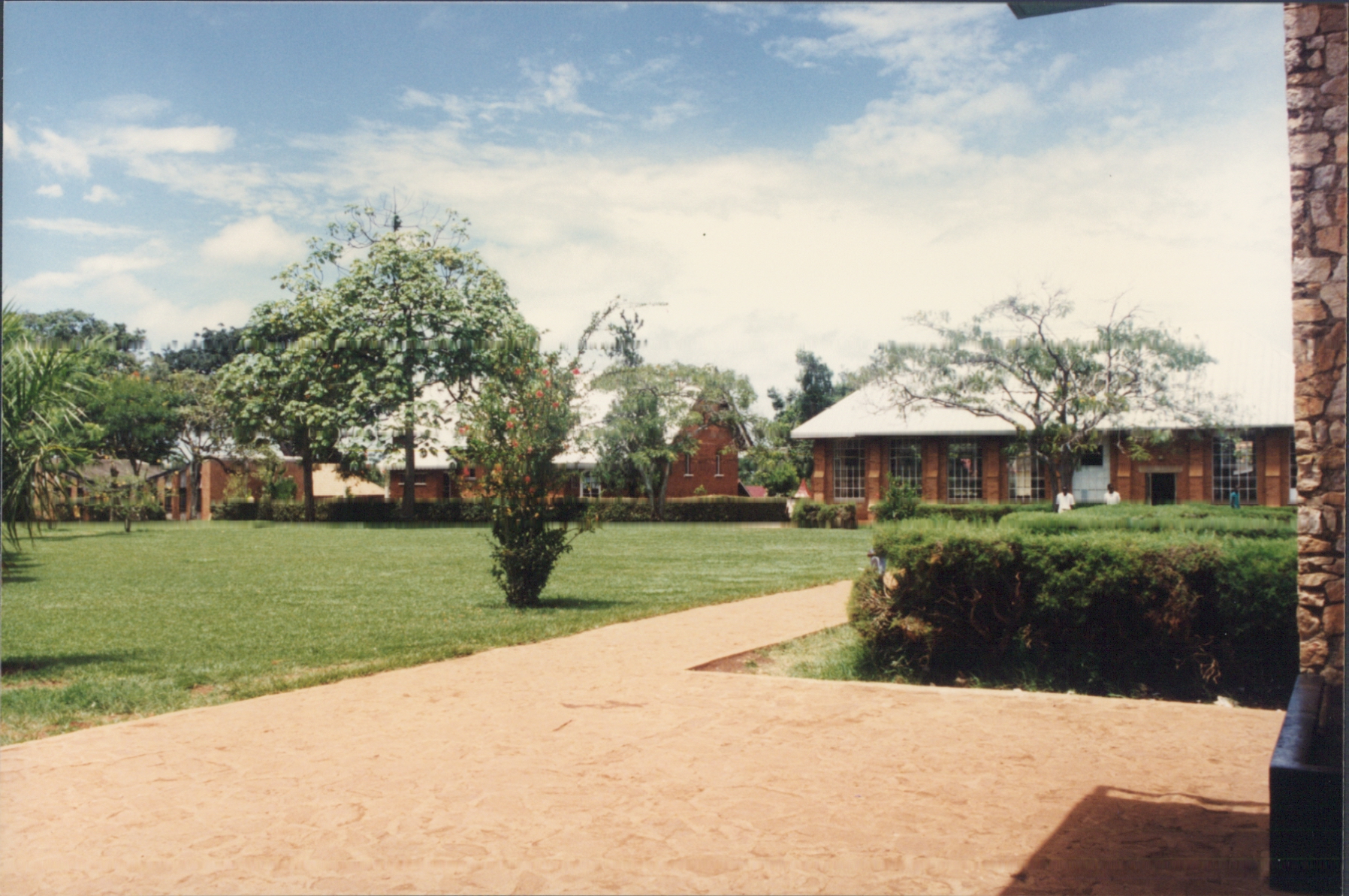 Old Library (left) and Biology Lab (right) - April 1996
Old Library (left) and Biology Lab (right) - April 1996
Striking to note the number of men who are busy building and renovating the school. This school will rise again. It has had great headmasters who have done their best under extremely difficult conditions. Dan Musisi Kyanda, Ishmael Uyiwroth, Eliezer Bawuba deserve greater credit and honour than they have received. Then there is Stephen Kamuhanda, the best headmaster that Budo never had. Ntare School is very lucky to have him.
What used to be the old library over the arch is now the computer room. There are six computers that are used by students on a voluntary basis. This is a wonderful thing. Whereas one gets the sense of time and history in this school, one realizes that things have changed from the days when we used to use slide rules and log tables. Now students have an opportunity to use spreadsheets and the new software.
The classrooms next to what was Australia House by the Library Road are a little rundown. The brick arch that leads you into the classrooms is almost collapsing and one of the students informed me that in fact the Mutesa House door recently collapsed, fortunately without injuries sustained by anyone.
The road that was known as the Library Road during our time is now called Bursary road and the little telephone room and the study rooms are now used as a residence for the Head Prefect and the Deputy Head Prefect.
I have just crossed the Library road and I kind of get a transient sense of guilt as if I am committing a crime because it was a terribly illegal thing to do during our time. You were not allowed to cross this road after 7 p.m., for it served as the transition to the girls’ end. Even crossing it before 7 p.m. induced some guilt because one knew that one was being watched. Students and teachers might begin to wonder how come you are walking towards the girls’ end, you see. Such was the nature of a co-education school.
Interestingly, the student who is showing me around also indicates to me that walking down towards the girls’ end is a little uncomfortable for him. Incidentally, I remember one night in the late 1960’s when a love-smitten colleague, “Mr. B”, donned his girlfriend’s wrap-around cloth and walked down to the girls’ end. Crossing the lower sports field, Mr. B met Mr. Milford, one of our strictest teachers, and said hello to him in a feminine voice. Mr. Milford acknowledge the greeting and Mr. B walked all the way down to the girls’ end, saw his girlfriend, and walked back undisturbed. Whatever happened to Mr. B? It would be a treat to share an evening with him and his beloved, if the two of them continued their friendship.
A great Eucalyptus tree just below the Library Road, whose shade used to be a market remains. Right next to that tree used to sit a man called Congo. He used to sell us delicious roast groundnuts that became known as -you guessed it - Congo! What were his real names? Where did he come from? Was he really Congolese or was he from the Kasese/Rwenjura area? He was a friendly man.
There was also a Nnalongo who used to sell us Kabalagala (small banana pancakes) and Menvu (ripe bananas) and other goodies on Wednesday afternoons and during the weekend.
The old hockey field by the Girls’ end reminds me of my very first game when a classmate aimed his hockey stick directly against my shin and cracked it. All in fun and no malice intended, but the pain lasted many years. That was the end of my career as a hockey player.
Old Sabaganzi House looks pretty good. There is a double story building going up next to Grace House and that is going to be an extension to that dormitory.
Ms. Susan Gould’s House has a special place in my memory. My first main classroom teacher, Ms. Gould was a fine lady, with easy laughter and a kind heart. She would invite us over for tea, and use the opportunity to brush up on our table manners.
“Could I borrow your book Miss Gould?” I once asked her. “Yes you could,” she replied. I thanked her and proceeded to pick up the book. “I did not say you may,” she continued. She followed with a little session on the difference between “you could” and “you may.”
John Fyfe’s House is a little run down of course. Excellent view of Entebbe side. Mr. Fyfe was a Scotsman. He freely shared with us his unflattering opinion of the English. Some African students ended up taking sides in an English/Scottish conflict that had absolutely nothing to do with us. That has been part of the tragedy of Africa where we end up fighting wars that have nothing to do with our own traditions or history.
It is no wonder that even in 1996, as Ugandans get ready to elect a president and parliament, one hears of conflicts between Protestants and Catholics, most of whom do not understand that it is a conflict between Rome and London that goes back centuries and has really nothing to do with their lot in the villages in this country. I digress.
The old zoo, the gorgeous view of Entebbe and Lake Nnalubaale and the forests of Busiro are just as wonderful as always.
This brings back memories of quiet times that we used to have and conversations with many friends. Pity that we did not record our debates and banter.
Mr. Patrick Boston’s house still has that scary look. Even now I haven’t walked over to his house for fear that the offspring of his large collection of reptiles might still be around. He was a biology teacher who often walked around with snakes hanging over his neck. I am told he is still “collecting things” in England.
I note that the swimming pool at Nansove is in terrible condition and in need of major repair. Great times we had here, swimming and laughing and networking, oblivious to the reptiles that lurked in the nearby forest.
There is a harshness that has crept up into Budo. During our time, discipline was in the form of Reds (red-lined 8” X 11” paper on which we wrote essays) or the more severe punishment of carrying murram from Kabinja to the school.
Of course if one committed the most serious offenses such as being found drunk or in an uncompromising situation with a member of the opposite sex then one was suspended or even expelled from school.
Apparently, Budo is now a cruel place for those who commit fairly trivial offenses, such as being late for the mess or cutting manual work. I am told that prefects cane students and apparently they do so in a very harsh manner. This is truly a negative reflection on the school. Perhaps it is part of the general decay in morals and attitude in the country.
One wonders how far the long arm of Idi Amin has reached in the psyche of our nation if high school students can be beaten by colleagues who happen to be prefects. I understand that if a student is late for Mess, he or she may be asked to take off their shoes and walk bare foot along the concrete path across the upper school.
In my day, the worst that a prefect could do was to give one some tough talk or report one to the housemaster. We had a prefect nicknamed Mussolini and another one Hitler. But that is as far as it went.
The school drum is long gone. Now the students are beckoned with a gong using an old rim of a bus wheel. The academic excellence of the school seems to be on the mend with the very encouraging performance at the final exams recently. One still longs for the day when Budo will again be the number one school in the country as we used to take for granted.
There is a disturbing thing though, and that is the really changing morals. When one hears that students watch pornographic movies in their dormitories one can’t but feel saddened that this school that was once proud of its Christian heritage and high moral values would have sunk to that level.
It is quite a challenge for everyone, including parents, students, teachers, and the board of governors. As an interesting anecdote, the school Chaplain is so committed to convincing the school students about Christianity and salvation that occasionally he reportedly uses physical persuasion to convert students to the gospel. In one interesting incident, he is reported to have interrupted his sermon to discipline one student who was talking during this sermon.
He apparently jumped over to where the student was and pulled him out of the pew and kicked him and used a few other persuasive physical measures and then went back to the pulpit and suggested that the congregation joins him in prayer.
Well, what he did was perhaps not original. Jesus Christ used violence when he drove the moneychangers from the synagogue. The Lord might have also used force now and again with Peter who was a rather stubborn disciple. However, forced Christianity is, well, a mirage. Not even Reverend Hugh Sylvester would have contemplated a fight in the name of the Gospel.
Rev. Sylvester was our school chaplain. I have just passed by his house, with its magnificent view of Kampala from Budo. I remember Reverend Sylvester’s house as a place where we used to gather on Sunday Night at 8 for Christian fellowship.
Darkness falls. Time to head back to Kampala. It's been a great afternoon, full of memories and great hope for better days ahead. Thank you Mutabaazi mwene Gakwandi for your time and company.
April 24, 1996